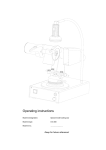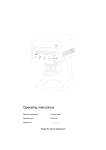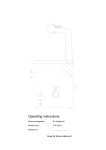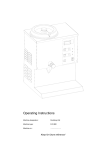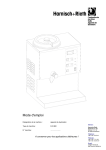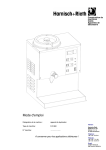Download Operating instructions - Harnisch+Rieth GmbH+Co.KG
Transcript
Operating instructions Machine designation: Triple workplace dust extraction unit Machine type: D-LE 280 Machine no.: ........................... Keep for future reference! Dear customer, Thank you for the confidence you have placed in us by purchasing this triple workplace dust extraction unit. Please take time to read these operating instructions carefully, especially before using the unit for the first time, as this will ensure that the unit will give you good service for many years to come. Contents 1 Safety..................................................................................................................... 2 1.1 Correct use ..................................................................................................... 2 1.2 Possible dangers ............................................................................................ 2 1.3 Approved operators ........................................................................................ 2 1.4 Safety measures at site of operation.............................................................. 3 1.5 Marking of safety references contained in these instructions ........................ 3 2 Starting up ............................................................................................................ 4 2.1 Technical data ................................................................................................ 4 2.2 Unpacking the triple workplace dust extraction unit ....................................... 5 2.3 Short description of unit and identification of components............................. 5 2.4 Starting up procedure ..................................................................................... 7 2.4.1 Pneumatic structure of tube/hose installation ...................................... 7 2.4.2 Structure of electrical installation ......................................................... 9 3 Operation ............................................................................................................ 11 3.1 Checking the filter system ............................................................................ 11 3.2 Automatic On-Off device / Connection of dust-generating devices.............. 11 3.2.1 Individual adaptation of extraction unit sensitivity to dust-generating devices.......................................................................................................... 12 3.3 Automatic air volume control ........................................................................ 12 3.4 Automatic shut-off and filter change control lamp ........................................ 13 4 Cleaning/Maintenance ....................................................................................... 13 4.1 Replacing the filter bag................................................................................. 13 4.1.1 Removing the filter bag ...................................................................... 13 4.1.2 Inserting the filter bag......................................................................... 16 4.2 Cleaning (replacement) of ultra-fine filter ..................................................... 17 4.2.1 Removing the ultra-fine filter .............................................................. 17 4.2.2 Fitting the ultra-fine filter..................................................................... 18 4.3 “Service” control lamp................................................................................... 18 5 Electrical fuse protection .................................................................................. 18 6 Warranty conditions........................................................................................... 19 7 EC declaration of conformity ............................................................................ 20 8 Appendix 1 .......................................................................................................... 21 8.1 Tube/Hose installation (3D) .......................................................................... 21 D-LE 280 - 18.09.03 / Vers.: 1 1 1 Safety 1.1 Correct use The D-LE 280 E triple workplace dust extraction unit is used in dental laboratories for extracting dust produced when working with instruments which generate dust. It should never be used for vacuuming liquids. The unit is suitable for collecting category C dust in compliance with the requirements laid down by the German Employers’ Liability Insurance Association (Berufsgenossenschaft) as defined in ZH 1/487. Unauthorized modifications and additions are not permitted for safety reasons! The operating and maintenance conditions specified in these operating instructions must be adhered to. Caution The unit is not designed as a medical device! Use on people is prohibited! 1.2 Possible dangers - Potential sources of ignition or combustible gases, vapors and liquids should not be extracted with the triple workplace dust extraction unit. - Particular attention should be paid to ensuring that the filter bag and ultra-fine filter are always installed correctly and undamaged, as the dust collected more or less poses a hazard to health! - Switch off the unit and disconnect from mains power supply before carrying out maintenance and cleaning work (pull out the mains plug). - The unit should be disconnected from the mains power supply before accessing the built-in electrical components! Danger The unit is not suitable for use in rooms where special conditions exist (e.g. corrosive or potentially explosive atmospheres). 1.3 Approved operators The operator of the unit should ensure that the operating instructions are accessible to the operating personnel and have been read and fully understood. Only then should the operator commission the unit. 2 D-LE 280 - 18.09.03 / Vers.: 1 1.4 1.5 Note Safety measures at site of operation - Air flowing out of the air outlet (6) should not be hindered in any way. - The distance between the air outlet and the next obstacle (e.g. a wall or furniture) must be at least 10 cm. The exiting airflow can also be conveyed away by connecting a hose to the fitting (6). - The unit should only be operated in cabinets or confined spaces if adequate ventilation is provided and the ambient temperature resulting from unit operation does not rise by more than (approx.) 10 °C. - No foreign bodies should be inserted through the ventilation ducts on the unit. - Ensure that the workplace always complies with pertinent accident prevention regulations by introducing appropriate internal company instructions and conducting inspections. Marking of safety references contained in these instructions Refers to tips and other particularly helpful information. Caution Refers to particular methods of operation or handling, non-adherence to which can lead to malfunctioning, damage or other problems. Danger Refers to dangerous situations which can lead to injuries. D-LE 280 - 18.09.03 / Vers.: 1 3 2 Starting up 2.1 Technical data Illus. 1: Side view with dimensions 4 Machine designation : Triple workplace dust extraction unit Machine type : D-LE 280 Unit dimensions : Width Depth Height Electrical connection : 230 Volt/50 Hz 200 mm, 594 mm, 597 mm Overvoltage category : II Power consumption : Max. 900 W The overall power consumption of all connected devices (in total) should not exceed 2200 W. Electrical fusing : 2x 16 A/T Air flow : max. 58 l/second (mains connection) Extraction hose connection : Ø 50 mm Dust collection : Up to approx. 10 kg (depending on dust type) Weight : Approx. 32,5 kg D-LE 280 - 18.09.03 / Vers.: 1 2.2 Note Unpacking the triple workplace dust extraction unit Inspect the packaging and unit for transportation damage and report any damage detected immediately to the haulage firm and/or supplier. 1. Place the carton on a flat surface. 2. Remove the top packaging material. 3. Push the packaging material away from the unit. Grasp hold of the unit by the lower edge. 4. The unit (weight = approx. 32.5 kg) should be lifted out of the carton by two persons. 5. Check the accessories: 2.3 - Documentation - Mains power cable - See delivery note for further possible accessories Short description of unit and identification of components The D-LE 280 triple workplace dust extraction unit has a powerful high-pressure fan which is fitted with noise suppression. It is also equipped with an automatic electronic ignition, an automatic shut-off feature with filter change indicator and automatic air volume control. Pneumatic stop valves are connected and automatically actuated when the respective dustgenerating device is activated, enabling free airflow at the specified vacuum duct. The automatic ignition electronics detect a rotating hand-held piece in a fraction of a second and immediately actuate dust extraction. The connected stop valve (accessory) automatically enables the extraction line immediately. Any commercially-available hand-held pieces can be used for this purpose. The D-LE 280 extraction unit is also used as an extractor for sand blasting instruments, saws and other dust-generating devices, electronic detection functioning here in the same manner. The dust is collected in a double-ply disposable filter bag with a capacity of up to 10 kg, depending on the nature of the dust. The ultra-fine filter has a large surface area and is serially connected to the disposable filter bag. It can even collect category C dust.1 1 Sicherheitstechnisches Informations- und Arbeitsblatt der Berufsgenossenschaft Nr.: 510210 (German Employers’ Liability Insurance Association safety information sheet) D-LE 280 - 18.09.03 / Vers.: 1 5 Illus. 2: View of installation unit from front right 1 2 5 6 7 8 9 Plate Electrical cabinet cover Vacuum fitting Ø 50 mm Exhaust air fitting Ø 75 mm Mains connection socket 230V/50Hz Ultra-fine filter cover Counteracting hook for quick-action closure 10 Ultra-fine filter 11 2x ultra-fine filter retaining strip 6 Illus. 3: Free-standing extraction unit with special plate 12 13 14 15 16 17 A 4x M6 nuts Quick-action closure Closure cover for filter bag Clamp closure Wire basket Filter bag 3x socket for dust-generating devices B 3x socket for automatic stop valves D-LE 280 - 18.09.03 / Vers.: 1 2.4 Starting up procedure - 2.4.1 Check filter system (see Section “3.1 Checking the filter system“). Pneumatic structure of tube/hose installation (see Illus. 2, Page 6, Illus. 4, Page 7, Illus. 5, Page 8) 1. Establish a hose/tube connection to the dust-generating devices (select a hose length which is a short as possible, maximum length approx. 2 m for each device). A hose can be connected to the Ø 75 mm exhaust air fitting. 2. Connect the automatic pneumatic stop valve to the compressed air supply (pneumatic connection (41), see Illus. 6, Page 9) Note All devices and installation components can be connected to the unit with flexible hoses or rigid plastic tubes (see following examples). table top Illus. 4: Laying tubing to devices over long distances 1a 2a 3a 4a 5a 6a 90° bend 90° angle piece PVC hose fitting Hose/Tube T-piece T-piece connection fitting 1 2 Dust-generating device no. 1 Dust-generating device no. 2 D-LE 280 - 18.09.03 / Vers.: 1 Ø 50 Ø 50 Ø 50 Ø 50 Ø 50 Ø 50 7a 9a 10a 11a 12a 37 3 T- piece connection fitting Ø 50 Reducer Ø 50 / Ø 45 / Ø 40 PVC hose fitting Ø 50 / Ø 45 / Ø 40 Hose/Tube Ø 50 / Ø 45 / Ø 40 PVC hose fitting Ø 50 / Ø 45 / Ø 40 Automatic pneumatic stop valve Dust-generating device no. 3 7 3. The 90° bend (1a) is used for hose/tube laying above the work plate (see Illus. 4 and Illus. 5). A Ø 60 mm hole is required in the work plate. 4. The 90° angle piece (1a) is used for hose/tube laying below the work plate (see Illus. 4 and Illus. 5) T-piece: Ø 50 / Ø 40 turnable T-piece: Ø 50 / Ø 50 turnable Illus. 5: Laying tubing to devices over shorter distances 8 D-LE 280 - 18.09.03 / Vers.: 1 2.4.2 Structure of electrical installation (see Illus. 6, Page 9) 1. Connect the dust-generating device mains power cable to socket A (socket Illus. 2, Page 6 and Illus. 6, Page 9). 1, 2, 3 ) (see 2. Connect the stop valve connection cable to socket B to (respective socket 1, 2, 3 ). Turn the outer sleeve (39) of the connector (38) to the right to lock the connector in socket B (bayonet lock). 3. Establish a connection to the mains power supply (230V/50Hz) with the mains cable provided (socket (7)). Illus. 6: Unit and electrical connections 5 6 7 19 36 37 Vacuum fitting Ø 50 mm Exhaust air fitting Ø 75 mm Mains power supply socket 230V/50Hz Main fuses (2x 16 A/T) Connection fittings Ø 45 mm Automatic pneumatic stop valve D-LE 280 - 18.09.03 / Vers.: 1 38 39 40 41 A B Connector with cable and solenoid valve socket Outer connector sleeve with bayonet lock Solenoid valve Pneumatic connection 3x socket for dust-generating devices 3x socket for automatic stop valves 9 1 2 Designation for unit socket and stop valve socket no. 1 Designation for unit socket and stop valve socket no. 2 3 Designation for unit socket and stop valve socket no. 3 4. Activate the main switch (20) (control lamp (21) illuminates green). 5. “Autom./autom.“ push button (22) illuminates green. Electronic designation for an active consumer is activated. - 6. Adapt extraction unit sensitivity to suit dust-generating devices (see section “4.2.1 Individual adaptation of extraction unit sensitivity to dust-generating devices“). 7. The extraction unit begins continuous operation after the “Hand/manual“ push button (23) is actuated (illuminates green). Illus. 7: Plate with control elements 20 21 22 23 24 25 10 Main switch Main switch control lamp (green) ”Autom./autom.“ automatic mode button “Hand/manual“ continuous mode button Push button for reducing air volume Push button for increasing air volume 26a 26b 26c 26d 27 28 Air volume display for one workplace Air volume display for two workplaces Air volume display for three workplaces Max. achievable air volume display “Filter change“ control lamp “Service“ control lamp D-LE 280 - 18.09.03 / Vers.: 1 3 Operation 3.1 Checking the filter system (see Illus. 2, Page 6, Illus. 10, Page 14, Illus. 12, Page 14) Caution The D-LE 280 triple workplace dust extraction unit should only be operated with a correctly fitted, undamaged ultra-fine filter (10) and filter bag (17). 1. Remove the filter bag closure cover (14). 2. Open the 2x quick-action closures (13) and remove the ultra-fine filter cover (8). 3. Ensure that the ultra-fine filter cartridge (10) is not damaged and is pressed tightly against the retaining strips (11) on the seal surfaces (35). 4. The four M6 nuts (12) ) should be tightened firmly and evenly. 5. The filter bag (17) should be undamaged when inserted in the wire basket (16). 6. Ensure that the cardboard gasket is held securely in the defined position by the retaining clip (50) and retaining hook (51). (see Illus. 16, Page 16). 7. The filter bag intake fitting (53) should sit tightly on the metal connection fitting in the filter bag chamber (33) (see Illus. 10, Page 14). 8. Clamp the ultra-fine filter cover (8) firmly with the aid of the two quick-action closures (13) on the housing and seal the filter bag chamber (33) tight with the closure cover (14) (see Illus. 2, Page 6). 3.2 Automatic On-Off device / Connection of dust-generating devices The extraction unit is equipped with an electronic On-Off actuator which reacts to most handheld pieces and other dust-generating laboratory devices. Caution The power input of devices to be connected should not exceed 900 Watt per socket A ( 1, 2, 3 ). The overall power input value of all connected devices should, in total, not exceed 2200 W. 1. Connect the dust-generating devices to sockets A ( 1, 2, 3 ). 2. Connect the automatic stop valves accordingly to sockets B ( 1, 2, 3 ). 3. The “Autom./autom.“ button illuminates green after the unit is switched on (main switch (20) ON) (see Illus. 7, Page 10). Note Please contact our H+R Customer Service Dept. (tel.: +7181/9678-0) if devices other than those which we have intended are to be connected! Please note Section “3.2.1 Individual adaptation of extraction unit sensitivity to dust-generating devices“ prior to this. The extraction unit starts automatically as soon as a connected dust-generating device is activated. The unit stops after a delay of approx. 8 seconds if all connected devices are deactivated. It is possible to adapt the unit individually if it does not react to a particular dustgenerating device. Please contact the H+R Customer Service Dept. in this respect. D-LE 280 - 18.09.03 / Vers.: 1 11 3.2.1 Individual adaptation of extraction unit sensitivity to dust-generating devices (see Illus. 8, Page 12) Note All dust-generating devices should be connected to the extraction unit and any other devices switched to stand-by mode (see Section “2.4.2 Structure of electrical installation“ in this respect). 1. Activate the extraction unit at the main switch (20). The control lamp (21) illuminates green. 2. Depress the “Hand/manual“ button (23) continually: • The unit starts during this period • The extraction unit automatically reaches its highest vacuum level during operation after a short period of time. The vacuum level is subsequently reduced automatically until the vacuum motor is shut down. 3. The “Hand/manual“ button (23) should only be released after the button (23) illumination is extinguished. • The extraction unit starts automatically after this 4. Actuate the “Autom./autom.“ button (22) briefly. The button illuminates green and the extraction unit changes to automatic mode. 3.3 Automatic air volume control The air volume is increased or decreased to suit the number of dust-generating devices in operation and is independent of the degree of dirt in the filter. The air volume can be identified on the illuminated LED’s (26a-d). The set air volume is then maintained at a constant level by electronic control until the automatic shut-off feature is triggered. The air volume can be altered by actuating button (24) (to reduce the volume) or button (25) (to increase the volume). Note Illus. 8: Plate with air volume display Illuminated LED (26a) is equivalent to the air extraction volume for one workplace. Illuminated LED (26a and b) is equivalent to the air extraction volume for two workplaces. Illuminated LED (26a, b and c) is equivalent to the air extraction volume for three workplaces. Illuminated LED (26a, b, c and d) is equivalent to the maximum achievable air extraction volume of the unit. 12 D-LE 280 - 18.09.03 / Vers.: 1 3.4 Automatic shut-off and filter change control lamp (see Illus. 2, Page 6) Note An underpressure sensor triggers the automatic shut-off feature and the “filter change“ control lamp (27) illuminates as soon as the max. permissible filter bag (17) filling level is reached. The extraction unit is switched off. 1. The filter bag (17) must be replaced (see Section “5.1 Replacing the filter bag“). Note The extraction unit can be switched on and off again or the filter bag (17) lightly beaten if the automatic shut-off feature deactivates the unit. The unit can then operate for some time without changing the filter bag. Open the clamp closure (15) and remove the closure cover (14) to lightly beat the filter bag (17). Note The ultra-fine filter cartridge (10) should be checked if the filter bag (17) is only slightly full after the automatic shut-off feature is triggered (filter change lamp (27) illuminates). See Section ”4.2 Cleaning (replacement) of ultra-fine filter“. 4 Cleaning/Maintenance (see Illus. 2, Page 6) Note The extraction unit can be switched on and off again or the filter bag (17) lightly beaten if the automatic shut-off feature deactivates the unit. The unit can then operate for some time without changing the filter bag. Open the clamp closure (15) and remove the closure cover (14) to lightly beat the filter bag (17). 4.1 4.1.1 Replacing the filter bag Removing the filter bag 1. Open the clamp closure (15) and remove the cover (14). Illus. 10: Removing the closure cover 14 Closure cover for filter bag 15 Clamp closure 16 Wire basket D-LE 280 - 18.09.03 / Vers.: 1 17 Filter bag 33 Filter bag chamber (Page 12) (Page 12) (Page 12) 13 2. Pull the filter bag (17) out of the extractor unit together with the wire basket (16). Illus. 10: Removing the wire basket 3. Pivot the retaining clip (50) away (see Illus. 12, Picture ; ). 4. Pivot the retaining hook (51) out of the cardboard gasket by rotating it (see Illus. 12, Picture ; ). filterbag 50 51 52 53 54 55 56 57 Retaining clip Retaining hook Cardboard gasket Intake fitting Cardboard gasket receiver Studs Closure cover Edge of round hole image without filterbag Illus. 12: Removing the filter bag 14 D-LE 280 - 18.09.03 / Vers.: 1 5. Press the cardboard gasket against the filter bag (direction C) (see Illus. 13). Detail X Illus. 13: Removing the filter bag 6. Close the filter bag (17) with the integrated closure cover (56) (move in direction E), pressing the stud (55) on the closure cover (56) in the lower part of the round cardboard gasket hole behind the edge of the hole, thus sealing it. (See Illus. 12 Picture = and Illus. 13 Detail X). 7. Take the filter bag (17) and wire basket (16) to a disposal point. Caution The disposable filter bag should never be emptied and reused as, apart from health considerations, this will lead to malfunctions. Note Compressed air should not be used to remove any dust which is present from the filter chamber (33)! D-LE 280 - 18.09.03 / Vers.: 1 15 4.1.2 Inserting the filter bag 1. Push the filter bag into the basket so that the V recesses (60) in the cardboard gasket (52) are inserted at a slant in the lower cardboard gasket receiver (54) (see Illus. 14 and Illus. 16). 2. Position the cardboard gasket firmly in the wire basket in a vertical position by pushing the retaining hook (56) into the hole (57) in the cardboard gasket (see Illus. 14 and Illus. 16). 3. Fix the position of the cardboard gasket in the upper area by pivoting the retaining clip (50) in the V recesses (61) of the cardboard gasket upwards (turning simultaneously), making contact between the filter bag and cardboard gasket (push the filter bag away from the cardboard gasket in the upper area during this operation) (see Illus. 14 and Illus. 16). Implement of the paper flange in the baket filterbag filterbag filterbag Bearing of the retaining bracket and of the hook (image without filterbag) Illus. 14: Inserting the filter bag Illus. 16: Positioning the cardboard gasket in a vertical direction 4. Push the new filter bag (17) together with the wire basket into the extractor unit. The filter bag is fitted tightly to the connection fitting in the filter chamber (33) during this procedure. 16 D-LE 280 - 18.09.03 / Vers.: 1 4.2 Note Cleaning (replacement) of ultra-fine filter The ultra-fine filter (10) should be removed and replaced after approx. ten filter bag (17) changes! We will gladly clean the ultra-fine filter (10) as part of an exchange, using only filters tested in accordance with ZH 1/487 Paragraph 2 (with test certificate complying with DIN 24 184). 4.2.1 Removing the ultra-fine filter 1. Remove the closure cover for the dust bag (14). 2. Open the 2x quick-action closures (13). 3. Loosen the 4x nuts (12) and lift out the ultra-fine filter retaining strips (11) (with slots) (see Illus. 13). 4. Remove the ultra-fine filter (10). Illus. 16: Removing the ultra-fine filter Caution The sealing surfaces (35) in the ultra-fine filter chamber should be free of dust, as dust can damage the vacuum motor. The filter chamber (33), ultra-fine filter chamber and sealing surfaces (35) should be cleaned by vacuuming. Compressed air should never be used!!! (See Illus. 10, Page 13 and Illus. 16). D-LE 280 - 18.09.03 / Vers.: 1 17 4.2.2 Fitting the ultra-fine filter 1. Insert the cleaned or new ultra-fine filter cartridge (10). 2. Mount the ultra-fine filter retaining strips (11) on the set screws from above (see Illus. 17). 3. Tighten the 4x M6 nuts (12) firmly and evenly. 4. Fit the ultra-fine filter cover and tighten firmly with 2x quick-action closures (13). 5. Check the filter system (see Section “3.1 Checking the filter system“). Illus. 17: inserting the ultra-fine filter retaining strips 4.3 “Service” control lamp The extraction fan should be replaced if the “Service“ control lamp (28) illuminates (see Illus. 7, Page 10). The extraction fan should only be replaced or checked by a qualified electrician. 5 Electrical fuse protection The entire unit is protected by two 16 A/T (2x) fine fuses (19). 18 D-LE 280 - 18.09.03 / Vers.: 1 6 Warranty conditions This device conforms with current safety regulations and was subjected to extensive testing before leaving the works. We grant a 12 months guarantee in which we are obliged to carry out all repairs necessary as a result of material or production faults free of charge. Warranty limitations: 1. The guarantee is considered void if repairs are not carried out by specialized dealers or by us. 2. Spare parts deliveries made for reasons covered by the guarantee do not lead to an extension of the original guaranty period. 3. Incorrect installation (e.g. failure to heed VDE* regulations or written installation instructions). 4. Incorrect operation or stress. 5. External influences (e.g. transportation damage, damage caused by impacting or blows, damage caused by the effects of weather or other natural phenomenae). 6. Repairs and alterations not carried out by authorized third parties. 7. Unit breakdown resulting from adjustment, alteration or any other attempt to adapt the unit is not considered a material or production fault. This guarantee neither encompasses the costs of such adjustment, alteration or any other attempt to adapt the unit, nor remedying of the resulting damage. 8. Normal wear and tear (e.g. spray nozzles, hoses, and including hand-held pieces, union nuts, glass panes, carbon brushes, illumination agents) or damage resulting from incorrect operation is not covered by the terms of guarantee. In order to provide you with a comprehensive service we would like you to fill out the guarantee return form (enclosed at the beginning of these instructions) and send it to us by fax or letter (window envelope). * Verband Deutscher Elektrotechniker (German Electrical Technician Association) Fax no.: 0 71 81/ 73 13 9 --- ------------------------- ------------------------- -------------------------- ------------------------- -------------- für Fensterumschlag hier falten-------------- -- Duplicate Guarantee return form Machine designation: Triple workplace dust extraction unit Maschine type: D-LE 280 Maschine no.: Date of purchase: Dealer/Store: Harnisch+Rieth GmbH & Co. Maschinenbau Postfach 1260 From: 73644 Winterbach Date/signature: 7 EC declaration of conformity as stipulated by the EC directive for machines 98/37/EC We hereby declare that the design of the machine specified below conforms with basic safety and health requirements of the listed EC directives. This certificate is no longer valid in the event of modifications being made to the machine which are not approved by us. Name of the manufacturer Address of the manufacturer Machine designation Machine type : : : : Harnisch+Rieth Küferstraße 14-16, 73650 Winterbach Triple workplace dust extraction unit D-LE 280 The following pertinent EC directives were applied: EC machine directive (98/37/EC) EC low voltage directive (73/23/EEC), equivalent to 1. GSG regulation of 11.06.79 EC EMC directive (89/336/EEC), equivalent to EMC law of 09.11.92 The following harmonizing standards were applied: DIN EN 292 : Machine safety. DIN EN 61 010-1 : Safety regulations for electrical measurement, control and laboratory devices. DIN EN 55 014 : Interference suppression of electrical devices and systems. DIN EN 55 104 : Electromagnetic compatibility, noise resistance requirements (category I). The following national technical specifications were applied: ZH 1/487 : Device for collecting dust which poses a health risk and reintroducing fresh air into workrooms. Technical documentation is available. The operation instructions relating to the machine are also available. Director of the Quality Control Department Winterbach, 15th March, 2000 8 Appendix 1 8.1 Tube/Hose installation (3D) exhaust air Illus. 18: Installation (3D) D-LE 280 - 18.09.03 / Vers.: 1 21























